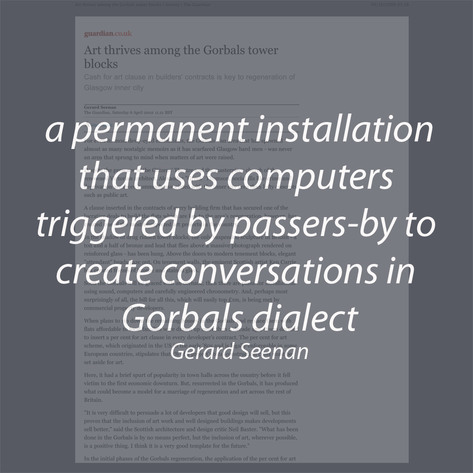guardian.co.uk : Art thrives among the Gorbals tower blocks
Publication Title: guardian.co.uk/societyWriter: Gerard Seenan
Publication Date: 6th April 2002
For even its most dewy-eyed enthusiasts, the Gorbals - an area that has spawned almost as many nostalgic memoirs as it has scarfaced Glasgow hard men - was never an area that sprung to mind when matters of art were raised.
Despite the presence of the Citizens' Theatre and the masterpiece church of the renowned Victorian architect, Alexander "Greek" Thomson, social ills like crime and deprivation are more commonly associated with the inner city area than lofty concepts such as public art.
A clause inserted in the contracts of every building firm that has secured one of the lucrative deals to build the flats which are key to the area's regeneration, however, has created one of the most unexpected art projects in the country.
In the shadow of drug ridden tower blocks, the only suspended sculpture in Britain - a ton and a half of bronze and lead that flies above a massive photograph rendered on reinforced glass - has been hung. Above the doors to modern tenement blocks, elegant "attendant" heads gaze out. On tenement walls, the eminent Scottish artist Ken Currie has created friezes of bronze and stained glass.
Soon the Gorbals will be graced with an orchard; then there are plans for installations using sound, computers and carefully engineered chronometry. And, perhaps most surprisingly of all, the bill for all this, which will easily top £1m, is being met by commercial property developers.
When plans to rip down the remaining houses in the Gorbals and replace them with flats affordable to local families were drawn up more than a decade ago, it was decided to insert a per cent for art clause in every developer's contract. The per cent for art scheme, which originated in the US in the early '80s and is legally enforceable in some European countries, stipulates that 1% of a project's total construction costs must be set aside for art.
Here, it had a brief spurt of popularity in town halls across the country before it fell victim to the first economic downturn. But, resurrected in the Gorbals, it has produced what could become a model for a marriage of regeneration and art across the rest of Britain.
"It is very difficult to persuade a lot of developers that good design will sell, but this proves that the inclusion of art work and well designed buildings makes developments sell better," said the Scottish architecture and design critic Neil Baxter. "What has been done in the Gorbals is by no means perfect, but the inclusion of art, wherever possible, is a positive thing. I think it is a very good template for the future."
In the initial phases of the Gorbals regeneration, the application of the per cent for artscheme was lacklustre. "We would have developers coming to us at the end of the project asking 'are you serious about this?' and the art ended up being tagged on as a bit of an afterthought," said David Hogg, the project manager.
In an attempt to add rigour to the programme, Heisenberg, an artists group run by sculptor Matt Baker and photographer Dan Dubowitz, was brought in. They worked with architects from the planning stage to produce art more integral to the design, which culminated in the massive Gatekeeper suspended sculpture.
"If you go back to the period before the 1920s, sculpture was an integral part of architecture," said Mr Baker. "Then with the modern movement and the obsession with budgets it fell away. I would argue that an art element is essential to a building project - and this proves it doesn't have to be restricted to the most expensive housing."
Although the Gatekeeper has had a mixed critical reception, it is popular with Gorbals residents and new house buyers: flats with views of it and the other art works are in greatest demand in the area.
The next stage of the Gorbals regeneration, a £50m development in Queen Elizabeth Square, will see at least £500,000 spent on art. Already a diversity of projects has been commissioned: local artist Amanda Currie is designing an inner city orchard; David Cotterrell is making a permanent installation that uses computers triggered by passers-by to create conversations in Gorbals dialect; the Berlin-based artist David Ralston has created huge sculptures of flocking birds that are influenced by the elements.
Not everyone, however, is convinced the per cent for art scheme is workable across the rest of the country. "Forcing developers to set aside 1% can be something that really gets their backs up," said Jess Fernie, of the Royal Society of Arts. "I also don't see any reason why art should be incorporated into every building, good architecture should stand on its own."
But, despite some criticism of the individual artworks, everyone involved in the per cent for art scheme in the Gorbals thinks it is a success.
"There are obviously challenges in trying to marry art and architecture and it can be quite difficult. But it is ridiculous to say that architecture has to stand alone," says Paul Keenan, an architect with the Hypostyle practice that worked on much of the Gorbals. "I would definitely get involved in similar projects again. If nothing else, it's got everyone talking - and how many building projects can you say that about?"
Gerard Seenan
Download this file here, or click the image on the right.Share:
Twitter / Facebook / Pinterest
